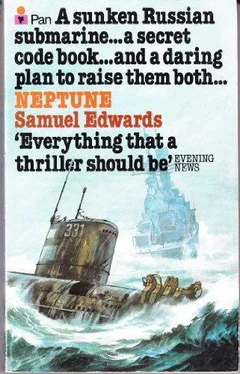‘Submerge with all possible speed,’ the commander ordered.
‘Gas contraction pressure is now twelve point two per cent,’ the bo’s’n said as he monitored the instrument panel located aft in the cigar-shaped bathyscaphe. ‘Rate of descent is increasing, sir. We’re about to hit eleven thousand feet. Now. Eleven thousand.’
The commander of the heavy steel underwater craft nodded, and there was no sound but the hum of the generator that provided the electric current. The basic design of the bathyscaphe had remained unchanged since the first had been developed by Auguste Piccard prior to World War Two. The generators pumped oxygen into the cabin and electromagnets held the iron bars used for ballast firmly in place on the hull; when they were released the vehicle would rise to the surface.
The executive officer peered out of the thick glass porthole, adjusted the beams of the twin searchlights that cut through the dark sea and reported to the mother ship, the USS New Haven, which rode at anchor more than two miles above them in the South China Sea. ‘The school of fish have disappeared. No marine life. No obstructions.’
The bathyscaphe shuddered slightly as it picked up additional speed, and all five members of the crew were aware of the change. ‘Keep an eye on the gas “float”,’ the commander told the engineering officer.
‘Aye aye, sir.’ The order was unnecessary, but the routines followed on a dive to the bottom of deep sea trenches were unvarying. ‘We’re holding our own.’ He stared at a shrinking column of mercury in a tube.
‘Contraction is thirteen point one per cent, sir,’ the bo’s’n called.
The commander allowed himself the luxury of a tight smile and ran a hand through his short hair. The gasoline stored in the so-called spherical ‘float’ attached to the underside of the cabin had reached its maximum rate of compression. Its density, which rose considerably in comparison with that of the water as the bathyscaphe descended, provided the thrust that was sending the craft to the bottom.
‘Thirteen thousand four hundred feet, sir!’ the bo’s’n said.
The commander turned to the one inactive member of the crew. ‘Prepare your cameras.’
‘Aye aye, sir,’ The young lieutenant checked his four automatic cameras, each attached to a porthole.
Suddenly the executive officer clasped a hand to his earphones. ‘Oh-oh!’
The atmosphere became tense.
‘The skipper has picked up an unidentified aircraft on his radar. Approaching the New Haven at eight hundred mph.’
All five instantly understood the significance of the unexpected development. If the intruder was a Russian military plane it meant that Soviet intelligence had learned of the mission, and then the troubles would begin.
The commander kept his head. ‘There’s nothing we can do about it, so let’s stay on the job. Let the skipper do his own worrying.’
‘Fourteen thousand three hundred feet, sir,’ the bo’s’n said.
The executive officer again held a hand to his earphone, then slumped in his seat. ‘We’re okay, sir,’ he said. ‘RAF reconnaissance aircraft on a routine mission out of Hong Kong. I don’t know what the skipper told him, but everything is under control topside.’
The commander had already dismissed the aircraft from his mind.
‘Switch on your sonar at fourteen thousand eight hundred,’ he told the chief engineer.
‘Aye aye, sir.’ The younger officer’s reply did not reflect his surprise. Surface soundings had indicated that the object they were seeking was sitting on the sea bed at a depth of more than three miles, so the commander obviously was taking no chances by directing that the bathyscaphe’s underwater detection device be placed in use before they reached the trench.
‘Fourteen eight,’ the bo’s’n said.
The chief engineer pressed a red button on his console, pulled a switch and began to manipulate a set of sensitive dials,
A low, humming sound filled the small cabin,
‘Fifteen thousand two hundred.’
The executive officer spoke into a small microphone suspended from his neck, the hum of the sonar making his words inaudible to the other crew members,
‘Fifteen seven.’
‘You may release one thousand pounds of ballast,’ the commander said, and the others knew he was slowing the craft’s descent so it wouldn’t crash into the ocean floor.
‘Very good, sir.’ The bo’s’n punched a tab with a practised hand.
For a moment the hissing of the oxygen vents stopped as the bathyscaphe’s rate of fall was checked, but the flow of pure air resumed again, and the crew breathed more easily. Any interruption of the air supply at this depth would mean certain death within minutes.
‘Fifteen eight, sir,’ the bo’s’n said.
At almost the same instant there was a jarring sensation as the craft touched bottom.
There was no change in the steady hum of the sounding device.
The commander moved to a place beside the chief engineer, gripped a wheel and pumped his right foot on a pedal. The bathyscaphe crawled slowly along the ocean floor.
The operation had reached a crucial stage, and two additional searchlights were snapped on, straining the craft’s electrical power to its limits. Modern science enabled an undersea search vessel to perform miracles, but only men could guide it, and locating an object at a depth of three miles taxed the resources of even the most experienced crew.
‘The skipper says we’re heading off course,’ the executive officer said. ‘Veer two points to starboard, sir.’
The commander made the necessary correction.
‘Fifteen thousand nine hundred, sir,’ the bo’s’n said.
The commander grinned. The ocean floor was sloping downward, so a heavy object would drift to the lower regions of the trench. If the original calculations were correct, all he had to do was to push forward.
‘Fifteen thousand nine hundred and fifty feet, sir!’
‘One point to port, if you please, sir!’
For the next quarter of an hour there was no sound in the cabin but the hum of the sonar, ‘Sixteen thousand, sir. Sixteen thousand one hundred. There’s a sharp slope here. Sixteen two!’
The hum stopped abruptly, and was replaced by a sharp, intermittent beeping sound.
The commander donned a microphone and headset. ‘Captain,’ he said calmly to the skipper of the mother ship, ‘I’ve established contact with an unidentified object.’
The executive officer moved to the forward porthole, located in the nose of the cigar-like vessel, and trained all four of the searchlights in a criss-crossing pattern.
The tension in the bathyscaphe mounted as the beeping sound grew louder.
‘On target, sir!’ the executive officer said, and could not keep his excitement from his voice.
‘Commence photographing!’
‘Very good, sir.’
With the commander expertly manipulating the controls the bathyscaphe moved still more slowly.
The sonar beeps were so loud they became painful.
‘Twenty feet ahead, sir!’ the executive officer shouted.
‘Turn off the sonar!’
‘Aye aye, sir.’
The silence in the bathyscaphe was deafening.
‘Ten feet, sir!’ The executive officer’s voice trembled.
The commander halted the craft, then moved forward to the porthole, a remote control steering apparatus the size of a portable radio in one hand.
Directly ahead and caught in the crossbeams of the searchlights was a black metal object. In places the paint had peeled away, and the steel beneath it was covered with a coating of green slime.
Читать дальше












